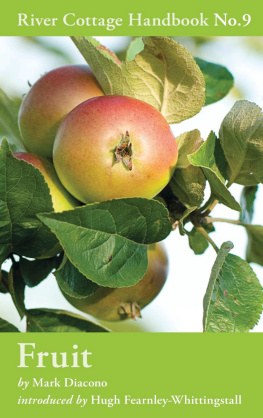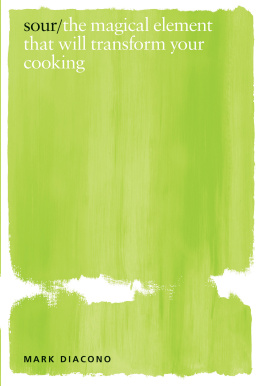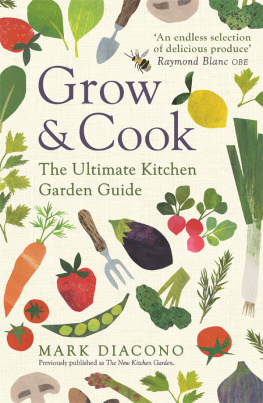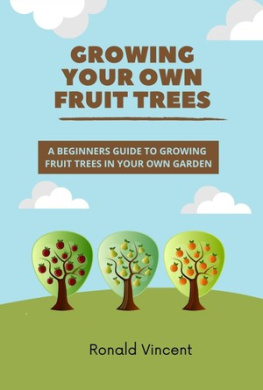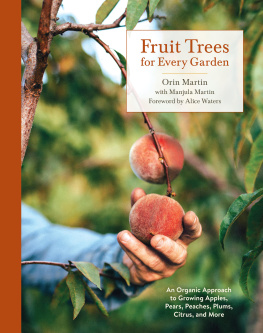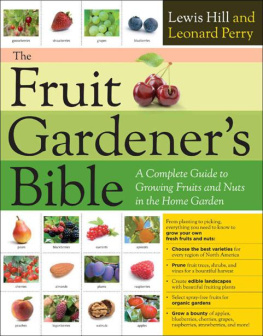
For my mum
Bloomsbury Publishing
An imprint of Bloomsbury Publishing Plc
50 Bedford Square
London
WC1B 3DP
UK
1385 Broadway
New York
NY 10018
USA
www.bloomsbury.com
This electronic edition published in 2018 by Bloomsbury Publishing Plc
BLOOMSBURY and the Diana logo are trademarks of Bloomsbury Publishing Plc
First published in Great Britain 2011
Text and photography copyright 2011 by Mark Diacono
Illustrations 2011 by Toby Atkins
Mark Diacono has asserted his right under the Copyright, Designs and Patents Act, 1988, to be identified as Author of this work.
All rights reserved
You may not copy, distribute, transmit, reproduce or otherwise make available this publication (or any part of it) in any form, or by any means (including without limitation electronic, digital, optical, mechanical, photocopying, printing, recording or otherwise), without the prior written permission of the publisher. Any person who does any unauthorised act in relation to this publication may be liable to criminal prosecution and civil claims for damages.
For legal purposes the and photography credits constitute an extension of this copyright page.
No responsibility for loss caused to any individual or organization acting on or refraining from action as a result of the material in this publication can be accepted by Bloomsbury or the author.
British Library Cataloguing-in-Publication Data
A catalogue record for this book is available from the British Library.
Library of Congress Cataloguing-in-Publication data has been applied for.
ISBN: 978-1-4088-0881-8 (HB)
ISBN: 978-1-4088-9633-4 (eBook)
Project Editor: Janet Illsley
Designer: Will Webb
Illustrator: Toby Atkins
The publishers would also like to thank Sam Carlisle for his assistance.
While every effort has been made to ensure the accuracy of the information contained in this book, in no circumstances can the publisher or the author accept any legal responsibility or liability for any loss or damage (including damage to property and/or personal injury) arising from any error in or omission from the information contained in this book, or from the failure of the reader to properly and accurately follow any instructions contained in the book. The recipes supplied in the book are for personal use only. No recipe may be used for commercial purposes without the express permission of the author.
www.rivercottage.net
To find out more about our authors and their books please visit www.bloomsbury.com where you will find extracts, author interviews and details of forthcoming events, and to be the first to hear about latest releases and special offers, sign up for our newsletter.
Contents
Its no secret that Im an absolute fruit fiend. I revel in the stuff, I am in awe of its utter deliciousness and its evolutionary neatness. If one food was designed, unambiguously, to be eaten, then surely it has to be fruit. We consume it, we spread the seed, more fruit grows, everyones happy. Its in Natures best interests to make it as enticing as possible and shes certainly done so. Fruit is a real treat that often needs no embellishment and is resoundingly, unequivocally good for us. Mark Diaconos first River Cottage handbook, Veg Patch, was a joy: a thorough, yet accessible guide to raising homegrown produce that has established Mark as one of the foremost thinkers and writers on the subject of growing what you eat. Now hes turned his attention to fruit and, as youre about to discover, has written another confidence-inspiring, anxiety-reducing little gem... or perhaps that should be little peach.
Its no mean feat, because getting people to grow their own fruit presents particular challenges. In many ways its the last frontier of domestic horticulture. While theres been a revolution in the growing of vegetables and herbs in the UK in recent years, home fruit growing has lagged a little behind. I suspect this is because theres a certain air of mystery attached to growing fruit, a sense that specialist knowledge and hard-won skills must be acquired before one can make a go of it. Also, being that much more delicate and squashable than a celeriac or a carrot, a raspberry or a plum can appear to need rather more cosseting. In his gardening courses at River Cottage, Ive seen Mark banish these myths and give people the confidence to start producing their own berries, apples, plums, melons and apricots. This book, I know, will do the same thing. As Mark explains, fruit wants to grow you just have to let it and hes here to show you how.
Its a common mantra and how could I not endorse it that we should all be eating fruit every day, ideally several times a day. It is one of the easiest ways to add goodness, sweetness, colour and flavour to our diets. More than any other food, it makes us feel good in body and soul. Yet so often our fruit hails from far afield, cling-wrapped and air-freighted from some tropical clime, or super-chilled in little plastic punnets and transported from the far end of the country. Im not about to advocate that we all give up bananas and oranges, but there are so many fruits that can grow successfully in our own backyards, and I think we should give them precedence. Buying seasonal British fruit from a local farm shop, a pick-your-own farm or a good greengrocer is a very sound choice. But there is no more sustainable, and no more pleasing way to put fruit on the table than to grow it yourself.
I believe that everyone should have some fruit growing within their reach, for at least part of the year. You dont even need a garden to achieve this: a couple of blueberry bushes in a big pot on a patio, or a window box of alpine strawberries, is easy to maintain and delightful to plunder. If you have even a small garden, you can do much more: tiny plots can foster small, but very productive fruit trees, as well as compact currant bushes. Your location neednt hold you back either. In fact, as Mark points out, the urban or suburban gardener often has an advantage over the rural dweller when it comes to fruit growing. A sun-trap patio or roof garden can provide a microclimate where nectarines, apricots or greengages will flourish much more readily than they would in a windswept country acre. If you have anything approaching a regular-sized veg patch you can easily produce more fruit than you can immediately eat: a moderate garden can comfortably support a plum, a pear and an apple tree, plus several soft fruit bushes. Providing you get the hang of storing apples (not difficult, as Mark explains), and if you have a freezer, this can give you fruit from the end of May until well after Christmas.
In the first instance, I hope you will greedily peruse this book as one would a menu. Feast your eyes on the many different varieties of fruit that can be grown in this country and then think about the ones that appeal most to you. Marks perennial advice, which I heartily second, is that you should only grow what you like to eat. But with that in mind, you may want to ask yourself: are you sure you know what you like to eat? Or, to put it another way, keep an open mind, and an open mouth! Its easy to dismiss a lot of fruit even strawberries, plums and pears if youve only ever tried one bland, under-ripe supermarket variety. But a sun-warmed Royal Sovereign strawberry or a perfectly ripe Doyenne du Comice pear could completely change your mind.
And if you think you dont like apples, Id have to suggest that you simply havent met the right apple for you yet. There are hundreds of varieties to choose from. Im a bit of an apple fascist myself, favouring the crisp and the sharp nothing soft, woolly or too sweet for me so I grow the delectable Ashmeads Kernel in my garden, as well as Orleans Reinette, Blenheim Orange and Lord Lambourne. Im lucky to have the space to do that, but its possible now, through the wonders of modern grafting techniques, to have an apple tree which produces up to four different varieties of apple. You could produce Coxs, Bramleys, Russets and, dare I say, Ashmeads Kernel, all on one bit of tailormade rootstock.

